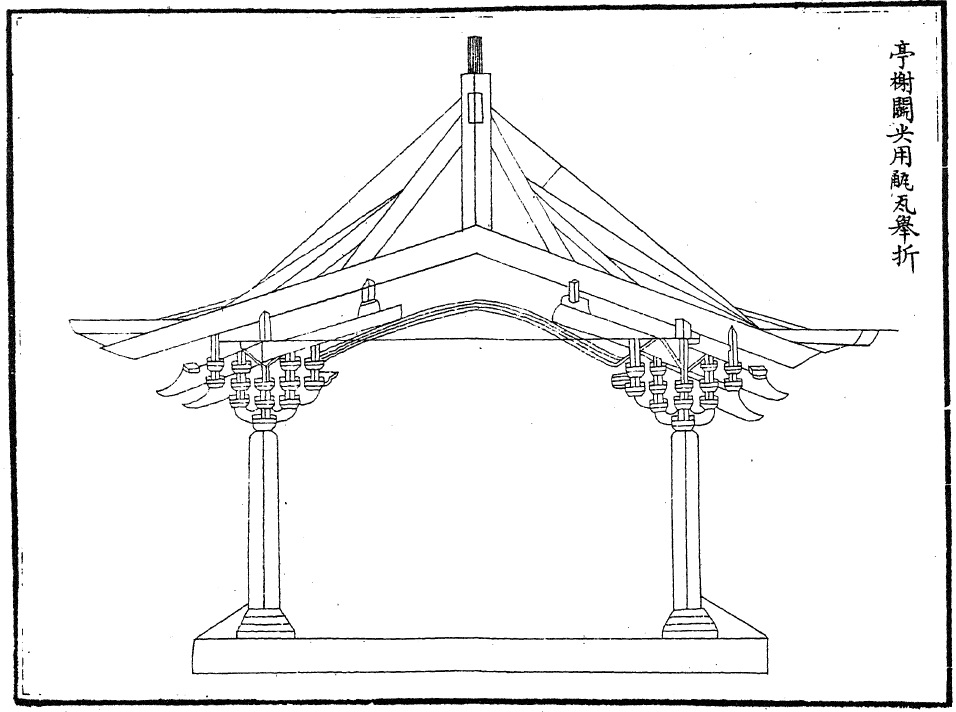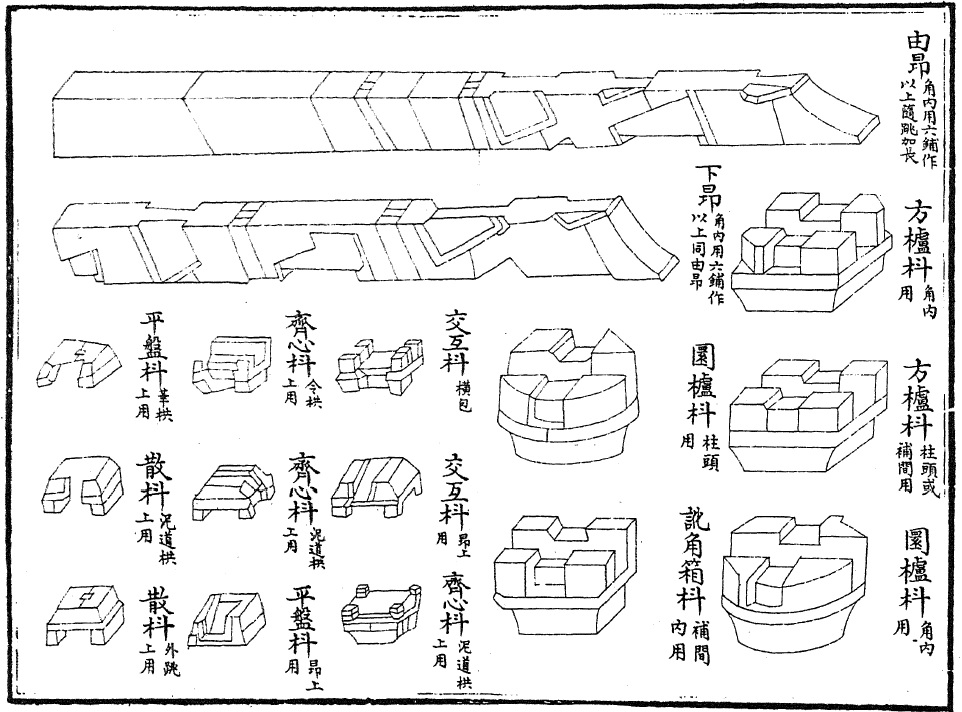Yingzao fashi 營造法式 "Standards and models for architecture" is China's oldest and most richly illustrated treatise on the architecture of state-owned buildings. It was compiled by the Northern Song-period 北宋 (960-1126) Director of the Palace Buildings (jiangzuojian shaojian 將作監少監) Li Jie 李誡 (1035-1110) on imperial order and submitted to the throne in 1100.
The first print was published in 1103. It includes practical advice for the organisation of construction work by the state and materials for construction (guanfang gongliao 關防工料 "construction work and material within the Pass and in the territories") and concrete advice for construction like standard measurements and design models.
The Yingzao fashi includes a large number of illustrations showing details of building structures and single parts. It has a length of 34 juan and begins with a chapter providing an historical and theoretical overview (kanxiang 看詳), and an index (mulu 目錄). In the first two chapters (Zongshi 總釋) 48 different buildings and details of buildings structure are described and explained. They also include an overview of the designations of single parts of a building. The chapter "general regulations" (Zongli 總例) defines the rules for construction work, like determining directions, fixing horizontal and perpendicular adjustment, calculation of square, round and other forms, thickness and length of construction parts, and principles of calculation and the use of different materials.
Chapters 3 to 15 include advice for particular rules (zhidu 制度) in construction work, like standard measurements of parts of a building, their dimensions and mathematical relations to each other. It also includes information to other material as timber, like bricks, tiles, or glazed tiles. Chapters 16 to 25 are called "Restrictions to work" (Gongxian 功限) and include regulations for the construction process itself, like manufacturing beams, joists and pillars, the assembling of these parts, the labour involved in times and cost, as well as special indications for transport tools like boats, carts or human labour. Material and labour are standardized to a very high extent so that it is easy to calculate how much material and labour is needed to construct a certain type of building.
Chapters 26 to 28 provide precedents for material (Liaoli 料例) and regulates which material is to be used for which purpose and in which amounts. At the end of these two chapters, a list gives insight into the complexity of a wide range of projects. The last five juan include illustrations.
The content of all these chapters is arranged in 13 categories according to the type of work, like brickwork, stonework, woodwork, carving, turnering, sawing, painting, and so on. Most of these processes are also common in modern construction work, except "trenching and fencing" (haozhai 壕寨), which is a preparatory work for the general adjustment of the building and the creation of a fundament.
 |
 |
Top: Drawing of the roof construction of a pavilion (ting 亭, xie 榭). Bottom: Complex groove-and-tongue pieces used for adornment at the architrave construction. From fascicle 30 of the Siku quanshu 四庫全書 edition. |
The book Yingzao fashi is a book that offers a complete picture of design, construction and calculation in the erection of ancient buildings. Most valuable is the description of measurements for materials (caifen zhi 材份制), so that a better insight into the principles of the design of ancient buildings is given. It also explains the differences in the design and construction of two different types of halls, the palace or temple hall (diantang 殿堂) and the common hall (tingtang 廳堂).
The Yingzao fashi gives information about details in construction work that have not survived or that are not any more used in modern buildings, be it appliances or ornaments, for instance, bamboo nets that are applied under the eves to prevent birds nesting in the construction, or ornamented bamboo mats spread out in the halls, or round painted plates attached to the rafters, or carved wooden boards wrapped around the beams. A lot of the technical terms in the construction business is still used today, while some others still need further research to be fully understood.
The book shows how important it was to standardize construction work that was organised and financed by government institutions, and how the bureaucrats of the Song responded to this need by curtailing expenditure by standardization. There are, nevertheless, some important points in construction work not mentioned in the Yingzao fashi, like the height of pillars or the depth and width of rooms.
The original print from the Song period is lost. The preface from 1145 is preserved in many later editions. In 1956 a fragment (juan 11 to 13, part of juan 10) of a Song-period print was discovered that was produced during the late Southern Song period 南宋 (1127-1279). The most widespread editions are the incomplete edition of Zhu Qijqin 朱啟鈐 (1872-1964) from 1919 that is a reprint of a manuscript owned by Ding Bing 丁丙; and the edition by Tao Xiang 陶湘 (1871-1940) from 1925 which is a text-critical edition based on the Ding Bing version and the editions in the series Siku quanshu 四庫全書. Both editions have several times been reproduced as facsimile prints, some of these in down-scaled versions. In 1983 Liang Sicheng 梁思成 published a commented study, the Yingzao fashi zhushi 營造法式注釋.